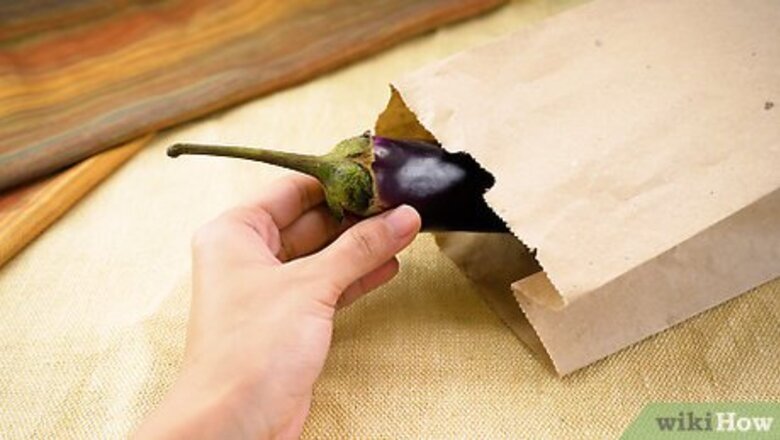
views
Keeping Eggplant at Room Temperature
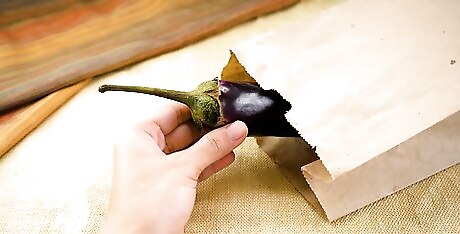
Wrap the eggplant in a paper bag. Place the whole eggplant in the bag. Don't cut it before storing it, since cut eggplant spoils very quickly. Instead, loosely wrap the vegetable in paper. You don't need to tie the bag shut or do anything else to it. The paper bag absorbs moisture. For that reason, storing eggplant in sealed plastic is not recommended. Sealed bags cause eggplant to spoil faster due to poor air circulation. If you don't have a paper bag, try wrapping the eggplant in paper towels and putting it in an unsealed plastic bag or vented bowl. You can store multiple eggplants together. Try to keep them from touching to allow moisture to escape. If you're using paper towels, wrap each eggplant separately.
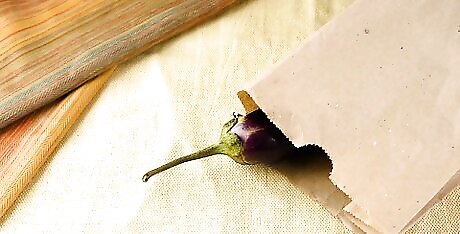
Store the eggplant in a room 50 to 54 °F (10 to 12 °C) in temperature. An eggplant is far more delicate than most people expect. It doesn't do well in extreme temperatures, including both the heat and cold. Keep your eggplant out of direct sunlight and in a relatively cool spot, such as in a kitchen cupboard or pantry. Refrigerators are too cold and often cause eggplants to spoil prematurely. On the other hand, many kitchens get too hot during the summer months. If your kitchen is warm, try storing your eggplant in a dry, well-ventilated garage, cellar, or basement.
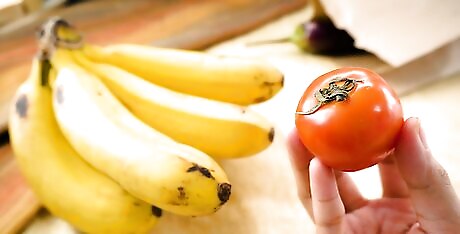
Store the eggplant separately from ethylene-producing produce. Ethylene is an invisible gas given off by many fruits, including bananas, tomatoes, and melons. Eggplants are highly sensitive to the gas. It causes them to spoil even when stored properly. Move your eggplant away from the fruit bowl, countertop, or other spots where you normally keep produce. The more you are able to separate eggplant from other fruit, the better off it will be. If you keep eggplant near fruit such as bananas, it may ripen almost immediately. Use it right away if this happens.
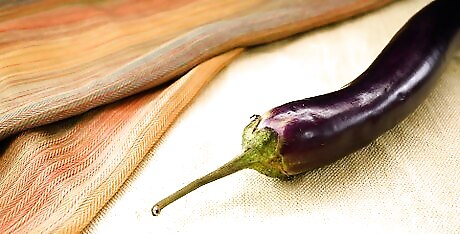
Use stored eggplant within three days. Unfortunately, fresh eggplant doesn't last long even with proper storage at room temperature. The best time to use eggplant is when it feels ripe to the touch. Press down on the skin with your thumb. If your thumb leaves a mark, the eggplant isn't ripe yet and you still have some time to keep it in storage. For the best texture and flavor, use eggplant within 24 hours of purchasing it. Keep in mind that eggplant starts spoiling as soon as it is removed from the vine. Any eggplant you buy has to go through days of shipping and shelf storage, so that is why it only lasts 3 days on average in your kitchen. Fresh eggplant has smooth, shiny skin and a bright green stem. Throw the eggplant away once it begins turning soft, brown, or slimy. Bruises and other damaged spots often mean that the eggplant's flesh has begun to decay. Use it as soon as possible if you notice discolorations.
Refrigerating Eggplant
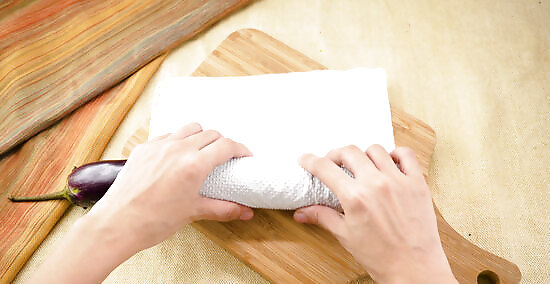
Place the eggplant in paper towels or an unsealed bag. Wrap it up loosely in a couple of paper towels to reduce the amount of moisture reaching it. Keep the eggplant whole until you're ready to use it. If you don't wish to use paper towels, store it in an open paper or plastic bag. Perforated plastic bags and open plastic containers are also an option. Sealing an eggplant in a bag or container restricts airflow to it, causing it to lose freshness at a faster rate than usual.
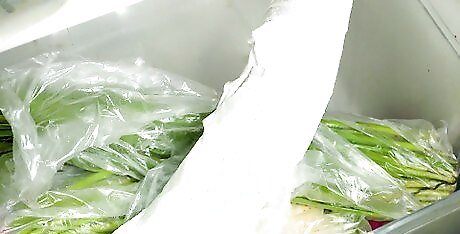
Store the eggplant in a crisper drawer if your refrigerator has one. Take advantage of storage drawers to keep eggplant away from moisture and other produce. Crisper drawers have humidity controls that keep produce fresher for longer. Simply set the wrapped or bagged eggplant in the drawer, then slide it closed. If you can't fit the eggplant in a crisper drawer, don't force it in. Instead, set it on a shelf inside your refrigerator. Keep in mind that it may not last as long as it would in a crisper.
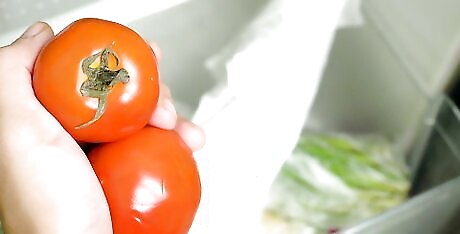
Remove other ethylene-producing produce from the drawer. If you have other items in the drawer, consider moving them somewhere else until you use the eggplant. Fruit is a common culprit behind eggplants that ripens prematurely. The invisible gas released by most fruit causes other produce to ripen at a faster pace. Some heavy ethylene producers include peaches, plums, and pears. Even produce like grapes, okra, and berries release small amounts of the gas.
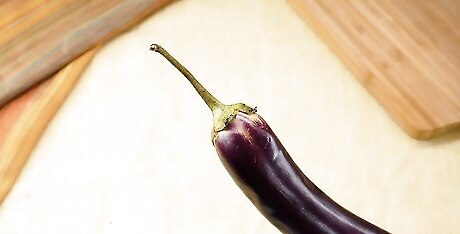
Use eggplant within 7 days of storage for maximum quality. This depends on how you stored the eggplant as well as how much time has passed since it was picked. Freshly-picked eggplant may last longer than a week, but usually, browning and softening becomes very noticeable before then. If you can, use eggplant within 3 to 5 days of storing it. Refrigerators are actually too cold for this delicate vegetable. Even if you store eggplant correctly, its color and texture may change. If you plan on using the eggplant right away and have storage space for it, leave it at room temperature instead.
Freezing Eggplant by Blanching

Wash and peel the eggplant. Hold the eggplant under cold water to remove any debris on it. Then, set it on a cutting board. Using a sharp knife, cut about ⁄4 in (0.64 cm) off of both ends of the eggplant. Remove the skin by running a standard vegetable peeler down the length of the eggplant. Ripened eggplants are the best choice for freezing. Make sure the eggplant looks uniformly dark and that its skin doesn't leave a mark when you push down on it with your thumb. The black varieties of eggplants hold up a little better in the freezer than the purple Thai and Chinese varieties. However, all varieties can be frozen and used for cooking. You can blanch eggplant without peeling it first. Unless you're using a very small eggplant, peeling is usually better. The skin on a larger eggplant tends to be tough, so it doesn't add anything desirable to dishes.
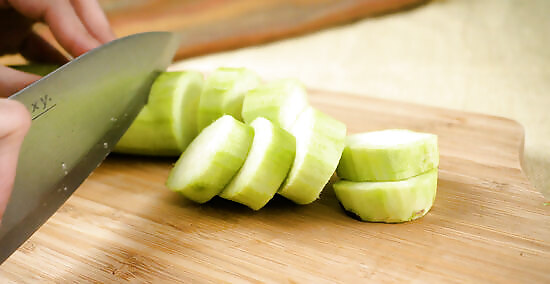
Cut the eggplant into slices approximately ⁄3 in (0.85 cm) thick. Starting at the stem, begin slicing the eggplant horizontally. Try to keep the slices roughly the same size so they are easy to store and cook at the same rate when you're ready to use them. Always use a clean knife on a rinsed eggplant to avoid contaminating it.
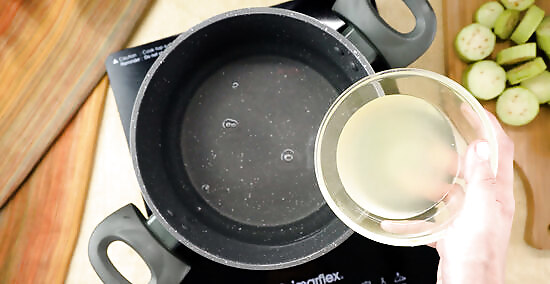
Boil a mixture of water and lemon juice on the stove. Fill a large pot about ⅔ of the way full with water. Make sure the water is deep enough to submerge all of the eggplant slices you wish to preserve. Add ⁄2 cup (120 mL) of lemon juice for every 16 cups (3,800 mL) of water in your pot. Warm the mixture over high heat until it bubbles rapidly. Lemon juice prevents the eggplant from changing colors while you blanch and store it. If you don't mind this, you could boil the eggplant in water only.
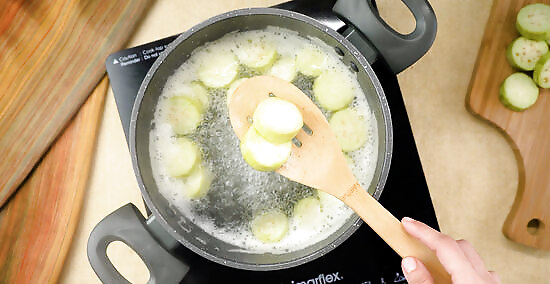
Cook the eggplant for 4 minutes. Start your timer as soon as the eggplant slices hit the water. Stay by the stove, since you need to get them out of the water right away to prevent them from overcooking. Scoop them out with a slotted spoon when they're done. If the water stops bubbling when you add the eggplant, don't wait for it to begin boiling again before starting your timer. Blanching is a way of briefly cooking the eggplant to remove enzymes that cause it to lose flavor and texture when frozen. Eggplant that isn't blanched before being frozen turns mushy.

Cool the eggplant in a bowl of ice water for 5 minutes. Transfer the eggplant immediately to a large bowl filled with ice cubes and cold water. Don't wait for the eggplant to cool before dropping it into the bowl. Submerge the slices in the water until it feels cold to the touch. Rapidly cooling the eggplant this way prevents it from overcooking. After cooling the eggplant, drain the ice water and pat the slices dry with clean paper towels.
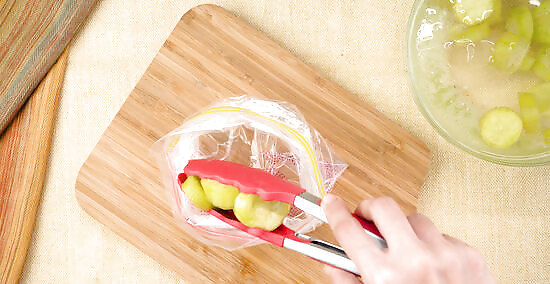
Place the eggplant in labeled plastic bags for storage. Pack the eggplant slices into resealable, freezer-safe bags. Leave about ⁄2 in (1.3 cm) of space at the top of each bag for expansion. Before sealing the bags, push as much air out of them as possible. Label the bags with today's date. To preserve eggplant for longer, use a vacuum sealer. A vacuum sealer sucks all the air out of the bag. Another way to do this is by sucking out as much air as possible with a plastic straw. If you wish to prevent the eggplant slices from sticking together, wrap them individually in a small sheet of plastic wrap. Then, pack them as you normally would. Doing this is great if you plan on frying the slices later.

Use frozen eggplant within six months for the highest quality. When you're ready to use the eggplant, move the bags to your refrigerator so the slices defrost. The sooner you use the vegetable, the higher quality you can expect. At most, try to use frozen eggplant within a year. If you vacuum seal the eggplants, they may last as long as 14 months. The freezing process causes eggplant to soften over time. For this reason, frozen slices are best in dishes that call for tender eggplant, such as soups, stews, sauces, and dips.




















Comments
0 comment